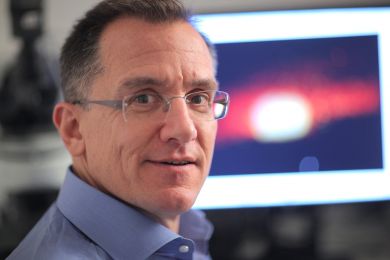 Dr Mark Rubin
Dr Mark Rubin
“Most tests are more appropriate for untreated or localized cancers,” explains Dr. Mark Rubin, director of the Englander Institute and the Homer T. Hirst III Professor of
Oncology in Pathology at Weill Cornell Medicine, vice chair for molecular and genomic pathology at NewYork-Presbyterian Hospital and head of the precision medicine program at both institutions. “Our test helps to anticipate mutations once a patient has undergone treatment, to help determine the next course of action.”
Rubin and his colleagues asked themselves what would be the best kind of genetic testing for advanced cancer. They decided that whole-exome testing captured the whole protein coding area to determine all possible mutations.
The EXaCT-1 test can reveal untapped therapies for patients with advanced cancers by scanning thousands of their genes. The test will soon be available for patients at Weill Cornell Medicine and NewYork-Presbyterian/Weill Cornell Medical Center, which developed the test. ExaCT-1 identifies alterations within tumors—some of which drive cancerous growth—on a magnitude up to hundreds of times greater than similar technologies designed to pinpoint the most precise ways of treating the disease, according to Rubin.
In May, the team published findings on its first 97 patients who underwent the test and found that scanning a patient’s tumor to look for any genomic mutations, as opposed to limiting the screen to mutations commonly associated with a given patient’s tumor type, was effective. In 92 percent of cases in the pilot program, the precision medicine team was able to recommend new treatment options based on the findings of the EXaCT-1 test.
President Barack Obama’s precision medicine initiative, announced in January 2015, dedicates $215 million from his proposed 2016 budget to expand data sharing between institutions; to develop new tests, like EXaCT-1, that identify genomic drivers in cancer; and to call for more research on how to apply findings in precision medicine to more effective therapies. Weill Cornell Medicine recently received approval for EXaCT-1 by the New York State Department of Health.
Most sequencing tests examine anywhere from 50 to 400 genes within a sample of a patient’s tumor to look for disease characteristics that physicians know can be effectively treated with particular drugs or other technologies. Many patients with primary cancers—those of the lung, breast, skin, blood and lymphatic system—will undergo this screening with their initial evaluation. Other patients will have these screenings done after their disease has spread, grown or stopped responding to treatment.
Unlike these focused tests, typically called panel sequencing, the EXaCT-1 assay takes an unbiased, exploratory look at more than 21,000 genes in cells both healthy and malignant, allowing researchers to find alterations in the cancer-development process in unexpected regions of the exome, where DNA is transcribed into RNA. Known as whole-exome sequencing, this type of test can be effective in advanced-stage patients for whom other treatments have failed, because it uncovers mutations that the less comprehensive tests miss. In practice, this means, for example, that a patient with bladder cancer whom EXaCT-1 shows to share a mutation associated with breast cancer might benefit from a drug typically prescribed to fight the latter type of tumor.
In such a situation, the oncologist can discuss the findings with the patient and insurers. Sometimes there will be cooperation from insurers and positive results, according to Rubin, who cited the need for more clinical trials.
The test, which is “very effective in identifying patients who would not be identified by other panels,” can be done quickly enough to “make a significant impact on a patient’s treatment plan,” according to Rubin. “The test identifies new treatments by finding new mutations that are targetable. Patients who would previously have been considered untreatable might now have hope for additional therapeutic approaches.”
EXaCT-1 requires a blood sample and a sample of the patient’s tumor. Computational biologists analyze the data and generate reports that summarize the key clinical and genetic findings. The precision medicine team reviews the results and consults with the patient’s oncologist to determine which treatment options and clinical trials might target the patient’s disease.
Rubin concludes: “The challenge is integrating genomic data with clinical data and trying to improve health. We’re interested in serving patients and saving lives. It’s an exciting time.”



